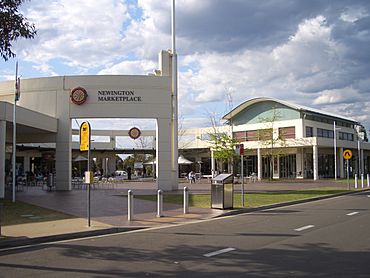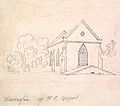Newington, New South Wales facts for kids
Quick facts for kids NewingtonSydney, New South Wales |
|||||||||||||||
|---|---|---|---|---|---|---|---|---|---|---|---|---|---|---|---|

Newington Marketplace
|
|||||||||||||||
| Population | 5,802 (2016 census) | ||||||||||||||
| • Density | 6,240/km2 (16,200/sq mi) | ||||||||||||||
| Established | 2002 | ||||||||||||||
| Postcode(s) | 2127 | ||||||||||||||
| Elevation | 18 m (59 ft) | ||||||||||||||
| Area | 0.93 km2 (0.4 sq mi) | ||||||||||||||
| Location | 18 km (11 mi) west of Sydney CBD | ||||||||||||||
| LGA(s) | City of Parramatta | ||||||||||||||
| State electorate(s) | Auburn | ||||||||||||||
| Federal Division(s) | Reid | ||||||||||||||
|
|||||||||||||||
Newington is a suburb located in western Sydney, New South Wales, Australia. It is about 16 kilometers west of the main Sydney central business district. Newington is part of the City of Parramatta local government area.
This suburb is just 2 kilometers west of Wentworth Point, which is on the Parramatta River. It is also 1 kilometer north-west of Sydney Olympic Park. Newington is most famous for being the home of the Athletes Village during the 2000 Summer Olympics and 2000 Summer Paralympics. After the games, the village was changed into homes for people to live in. Many other apartments and houses have been built here since then. There is a special memorial opposite Newington Marketplace. It lists all the Australian team members from the 2000 Olympic and Paralympic Games.
Contents
History of Newington
The suburb of Newington got its name from a large property called the Newington Estate. This estate was named by John Blaxland after his family's home in Kent, England.
First People of the Land
Newington is built on the traditional lands of the Wann-gal clan. These are Aboriginal lands. The Wann-gal people lived along the southern shore of the Parramatta River. Their land stretched between Cockle Bay and Parramatta.
European Settlement and Early Businesses
European settlers arrived in Australia with the First Fleet in 1788. Soon after, land was given out in large sections. From 1788 to 1831, these land grants were given to settlers from the Wann-gal lands.
In 1807, John Blaxland bought about 520 hectares of land. He named his new property Newington. Blaxland started several businesses on the land. He built salt pans along the Parramatta River. By 1827, he was making 8 tons of salt every week for Sydney. He also built a tweed mill, a limekiln, and a flourmill. His home, Newington House, was finished in 1832.
Over the years, the ownership of the Newington property changed hands several times. In 1860, the land was leased to the Methodist Church. They started Newington College on the site. Later, in 1877, the property was sold to John Wetherill.
People tried to find coal on the land in 1841 and 1878, but they were not successful. In the late 1870s, there were hopes to build many new homes in Newington. This was because Sydney's suburbs were growing fast. However, this plan did not work out very well at first. Only a few plots of land were sold. Still, the way the streets are laid out in western Newington today shows parts of this early plan.
Newington as a Public Hospital
In 1879, the government looked at the Newington Estate for public use. They decided it would be a good place for a hospital for aged women. The first buildings for this hospital were built in 1886. They could care for 300 patients. Over time, more buildings were added to the Newington Hospital.
In the 1960s, there was a plan to close the hospital. However, many people did not want this to happen. After long talks, the government decided to close the hospital in 1968. The property was then given to the NSW Department of Prisons. Some of the old hospital buildings are still used today within the Metropolitan Remand and Reception Centre.
In the late 1990s, the site was developed by Mirvac and Lend Lease. They built the athletes' village for the 2000 Summer Olympics. After the games, Mirvac turned the site into the new residential suburb we know today.
Shopping and Businesses
Newington Marketplace is an outdoor shopping center. It has a Woolworths supermarket. You can also find other specialty shops, cafes, and restaurants there. Newington also has some buildings with offices and warehouses.
Schools
- Newington Public School (NPS)
Gallery






